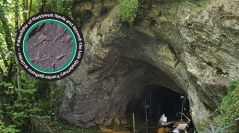

 Comptes Rendus Palevol
20 (42) - Pages 859-886
Comptes Rendus Palevol
20 (42) - Pages 859-886Iberia, a natural cul-de-sac peninsula, plays a major role in the study of the Neanderthals demise and its eventual relationship with the spread of Anatomically Modern Humans (AMH) in Europe. The site of Cova Eirós (Galicia, Spain), located in NW Iberia, contains Middle and Upper Palaeolithic levels, based on the cultural remains recovered at the site. No human remains directly associated with those levels were discovered yet. The available radiocarbon dates from the levels 2 (c. 35 ka cal BP, Early Upper Paleolithic) and 3 (c. 41 ka cal BP, Late Middle Paleolithic), point to a late survival of Neanderthal groups in North Iberia and to a relative quick arrival of the AMH, c. 35-36 ka cal BP, with respect to other territories of the Iberian Peninsula. The archaeological record shows clear differences between the Middle and the Upper Palaeolithic occupations, regarding raw-material acquisition, lithic technology and subsistence strategies. The location of Cova Eirós in the westernmost margin of the Cantabrian Rim and in the Atlantic Façade, makes this site a key place to understand the spread of the first AMH and the progressive demise of Neanderthal populations.
Middle-Upper Palaeolithic transition, Mousterian, Aurignacian, quartz industries, zooarchaeology, Northwestern Iberia